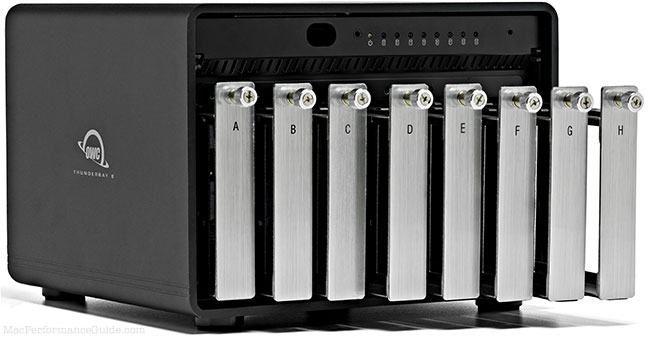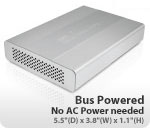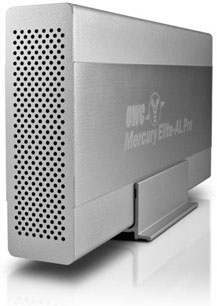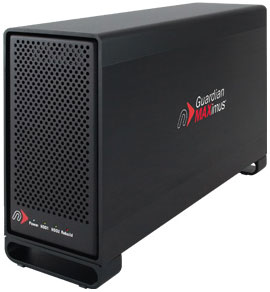
$220 SAVE $130 = 37.0% Western Digital 16.0TB Western Digital Ultrastar DC HC550 3.5-in… in Storage: Hard Drives
|

|

|

|

|

|

|

|

|

|
Upgrading Reliability and Backup
Related: backup, hard drive, How-To, laptop, Other World Computing, RAID, RAID-1, RAID-5, SSD, USB
Take action for the safety of your data before spending money on performance upgrades.
The best upgrade is the one that protects you when the worst happens, because high performance never replaces files that are lost forever.
Suggested drives are listed further below on this page.
Hard drives do not get better with age
Using any hard drive more than 18 months is not a great idea. As a hard drive ages, the risk of failure steadily rises, especially with inexpensive external drives, which often have low quality power supplies. Or with laptop hard drives.
Travel backup
I strongly recommend a travel backup drive using a solid state drive (SSD). Such a drive can tolerate impact and shock like no hard drive can. It is critical that you carry and use such a backup drive, because if the laptop is stolen, everything on it is gone. Keep this backup separate from your computer, so both aren’t stolen together. My preferred drive for travel is a Mercury Elite AL-Pro Mini with an SSD in it.
I also strongly recommend an SSD inside the laptop, again for its reliability. If you travel abroad on photographic expeditions, anything else is an unnecessary risk.
Backup locally with Time Machine for hourly protection
I wouldn’t work without Time Machine, because it has saved me hours of work when files or preferences go bad; I simply restore the problem files and continue my work. It also protects against drive failure of course, but that is rare.
A Time Machine backup is useful because it is always attached to the computer, backing up every hour. But that also means that it is at risk of the same perils as the Mac itself: theft, fire, flood, etc.
Store backups *off-site* for common perils
If your backup plan consists of one drive attached to your Mac, then you have an "at risk backup". Should fire, flood, lightning strike, or theft occur, your computer and backup stored near it are both history.
Keep at least two, but preferably three full backups stored well away from the computer where they are not subject to the same perils as the Mac itself. These are offsite backups. Once a week or after any major work, update the oldest backup, then return it to its offsite location.
Another option is to use a “cloud” data storage service. This presumes that you have a fast internet connection and an amount of data which is manageable over that connection. I recommend using such services only in conjunction with conventional backups to hard drives, as discussed above.
Suggested backup protocol
The easiest and fastest backup it via cloning, which copies only new or changed files. For most users, the following protocol is advised:
- Maintain a minimum of three (3) external drives which are stored away from the computer (off-site). One is not enough; it becomes an original whenever there is a failure. Two is tolerable, but at similar risks.
- Once a week, update the oldest backup, then return it to the off-site location.
For those who follow a separation of system and data protocol as I advise, clone Boot to BootClone and clone Master to MasterClone, where BootClone and MasterClone are two partitions on the same backup drive. This is another reason to get 2TB external drives (to allow space for both).
I do NOT recommend Time machine for off-site backup purposes, because files are not immediately self-evident, nor is the Time Machine backup bootable.
Mirror (or RAID-5) for reliability
For reliable external storage, a RAID-1 mirror sets up 2 or more drives as redundant; each is a copy of the others. Typically a mirror is two drives, though it is possible to have a 3-way or 10-way mirror.
With a Mac Pro, a RAID-1 mirror can be set up internally using two drives in two of the standard drive bays. With all Macs, plug-and-play options are available that contain a mirror internally. These can be connected with eSATA, Firewire 800 or USB (not recommended).
RAID-5 (striping + mirroring) is another option that offers higher performance along with resilience in the face of one drive failure.
Eight-bay Thunderbolt 3 high-performance storage for photo and video.
Hard drives or SSDs.
Non-RAID or RAID-0/1/4/5/10.
Capacities up to 144 Terabytes!
Suggested external drives
Backup drives: OWC Mercury Elite AL-Pro. Get the 2TB model for speed and capacity. Get three (3) of them for off-site backups, updating one per week.
External RAID-1 mirror: the NewerTech Guardian Maximus. An excellent choice for a reliable external Time Machine or other backup/storage. Two internal drives, tolerates failure of one internal drive.
External RAID 5: the OWC QX2. RAID-5 tolerates failure of 1 of 4 drives, can be run in other RAID modes as well.
Travel backup: the Mercury Elite AL-Pro Mini. I prefer one with an SSD installed, which is an especially reliable way to backup when traveling.
Seagate 22TB IronWolf Pro 7200 rpm SATA III 3.5" Internal NAS HDD (CMR)
SAVE $60

 diglloydTools™
diglloydTools™





